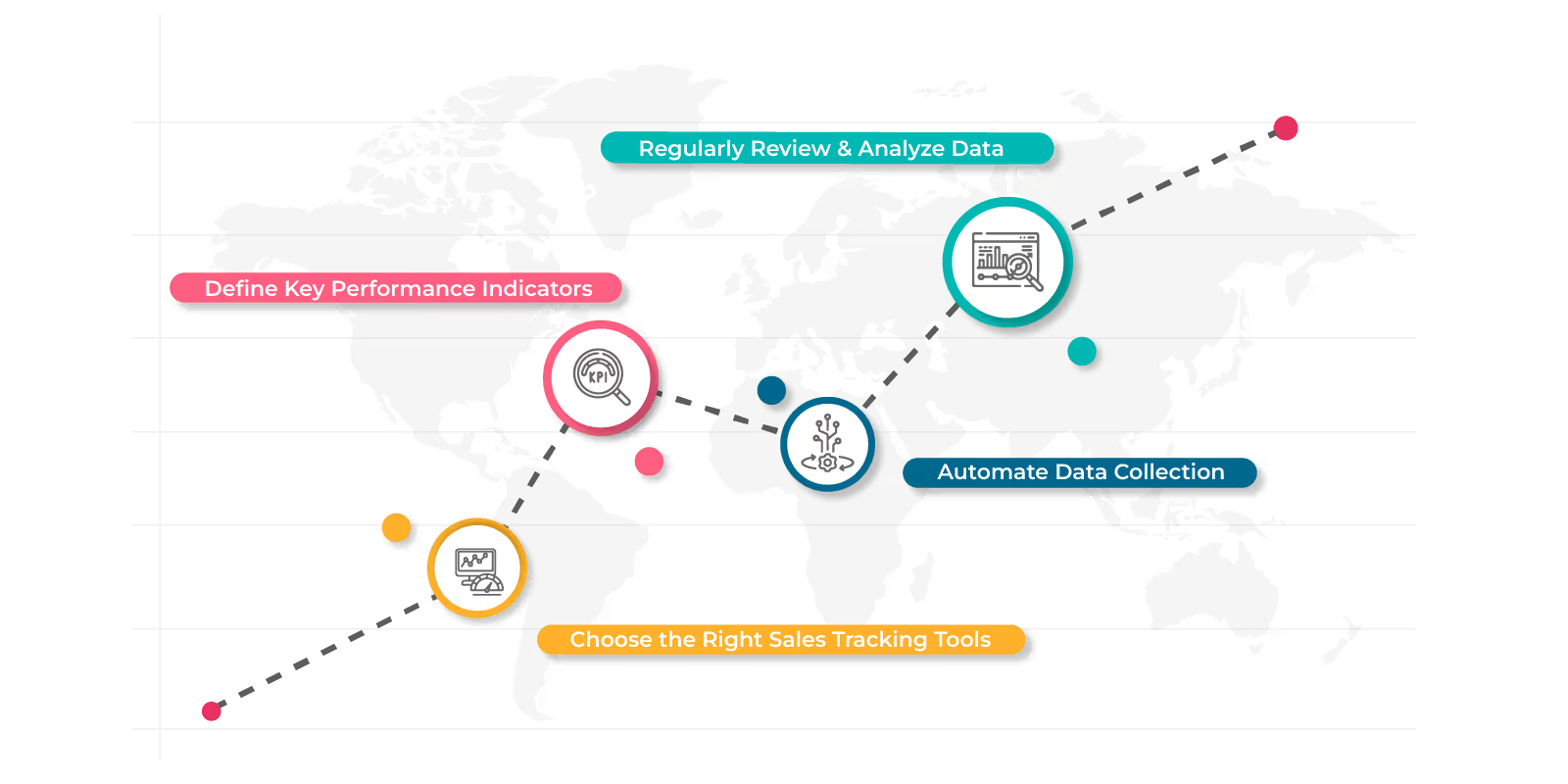
Blog
How to Create and Hit your Sales Targets Effectively?
February 22, 2024


Key Insights
What makes a marathon runner motivated to finish the long distance is the celebration of the smaller milestones on the way. It pushes them to complete the course step by step as the final destination is marked.
This is the same motivation that setting a sales target offers to the salesforce as well. It gives a sense of direction, clarity, and motivation to complete the race towards closing your sale.
So is it as easy as said?
In this article we will explore sales targets, their importance, how to create an effective sales target structure, how to effectively track it, and a few tips to hit your goals efficiently.
So scroll down for more.
What are sales targets?
Sales targets refer to the specific and measurable goals set for the sales team to achieve within a particular time period. Setting these milestones will help in objectively measuring the efforts and performance of your salesforce.
Additionally, setting achievable and realistic sales targets can be beneficial for an organization that uses management by objectives (MBO) approach. MBO enables the sales team to align their individual performance goals with the broader organizational objectives, promoting better coordination and ensuring that sales targets are in line with the overall strategic vision of the company.
Sales targets are set based on changing market conditions and industry trends. This regular review of the business environment will help in setting achievable sales goals that will drive the salesforce towards achieving the overall business objectives.
Why is it Important to use Sales Target?
Setting achievable and realistic sales targets will help sales at various levels. Let's look at some of the reasons why sales targets are crucial for your overall business success:
- Sales targets provide a clear sense of direction to the salesforce to achieve their goals and targets.
- Setting attainable sales goals will help motivate the salesforce, boost their performance, and help strategies to successfully achieve their targets.
- It provides objective milestones and metrics to evaluate the sales performance, appreciate their strengths, and identify areas of improvement.
- Sales targets help in effective resource allocation to enhance conversion rates.
- Sales targets help streamline the sales efforts to align with the larger organizational objectives.
- Finally, setting realistic sales targets will drive revenue generation, ensure market competitiveness, and enhance sustained business growth
The sales team, which includes sales associates vs sales executives, must therefore ensure to set sales targets according to their roles and responsibilities and evaluate their sales potential to assign goals that drive their motivation for better results.
How to create a Sales target?
Creating an effective sales target is crucial for our business growth. Like the various approaches in sales process, it provides a sense of direction to your salesforce.
Hence, it must be undertaken with careful planning and consideration. Let's look at a step-by-step guide to building a successful sales target example:

Set Clear Objectives
Setting clear, realistic, and achievable goals is very important for the achievement of your sales target. From customer acquisition, revenue generation, and market expansion sales goals must be specific, measurable, and aligned with the larger company objective for overall business growth.
Analyze Historical Data
Conducting regular evaluations of sales performance and tracking key performance indicators (KPIs) is an essential part of setting effective sales targets. This data-driven approach allows for the identification of areas for improvement and refinement of the sales process, leading to the creation of more realistic and achievable sales targets that are better aligned with the company's growth objectives.
Understand Market Conditions
Developing a sales transformation roadmap that integrates real-time market intelligence and competitor analysis into the sales process can enable the sales team to continually adapt to changing industry dynamics. This agile approach helps set dynamic sales targets that align with the evolving market landscape, ensuring that the sales strategy remains relevant and effective in achieving the organization's long-term objectives.
Segment Your Market
Sales target achievement cannot be uniformly set across all regions and demographics. There needs to be a segmentation of the market based on region, demographics, and product preferences as the product in high demand in one region might not be of want in other regions due to various factors.

Involve the Sales Team
Sales team must be involved while setting your sales target. Their participation will help in getting valuable insights and input that will help in setting realistic and attainable goals. It will also imbibe a sense of ownership and motivation in the salesforce to strategize for higher success rates.
Regularly Review and Adjust
The success of sales target achievement is based on various factors. Hence, there needs to be a regular review of these goals to ensure that they are on par with the changing marketing trends and industry requirements. In addition, there needs to be flexibility in changing the sales targets, incorporating metrics like ACV sales, to ensure their relevance and effectiveness.
Following this systematic sales target structure will help in building effective and efficient sales goals that will help boost your sales performance and enhance your business growth.
Read more about examples of selling concepts in marketing from the Advantages and Disadvantages of Sales Concepts.
How to effectively track Sales targets?
Implementing a tool or technique to optimize your operations requires regular monitoring and tracking to determine its effectiveness. Let us explore some of these ways to effectively track your sales targets:

Choose the Right Sales Tracking Tools
Implement a sales tracking tool that evaluates your sales activities, along with integrating a sales margin percentage calculator. Incorporating tools like Customer Relationship Management software, sales performance management solutions will help in objectively evaluating the progress made by each sales rep in their respective goal and target.
Define Key Performance Indicators
For objective evaluation of your sales activities, there need key performance indicators to base this progress. For example, determining the lead conversion rates, sales cycle length, revenue generated, deals closed, etc will help in making an objective analysis of your sales. Implementing advanced incentive compensation management solutions not only enables the tracking of these key performance indicators but also provides actionable insights to optimize sales strategies and incentivize desired behaviors effectively.
Automate Data Collection
Leveraging automation tools to ease your everyday sales activities will help in gathering valuable data. It reduces the error caused by manual handling of data and ensures accurate insights and decision-making.
Regularly Review and Analyze Data
Furthermore, a well-designed tracking system allows for a more accurate measurement of sales performance, enabling companies to better align compensation structures such as On-Target Earnings (OTE) with sales targets and objectives. By leveraging data analytics, companies can optimize their OTE compensation strategies to incentivize and motivate sales reps to achieve their goals, thereby fostering a culture of accountability and driving sustainable business growth.
Leveraging the right tools, determining relevant metrics, automating data collection, and regularly reviewing its impact will help in ensuring the effectiveness and efficiency of sales targets in bringing the desired results.
How to hit your Sales target?
For successfully hitting your sales targets it is important to set realistic and achievable goals for your sales reps. This involves understanding their potential and performance, evaluating the market and industry trends, and gathering relevant historical data influencing your sales goals.
In addition, it is also important to clearly communicate these goals and targets with your sales team. This will help them get a better understanding of what is expected of them, and give them a sense of direction to work towards strategic plans to achieve these targets.
Evaluating the effectiveness of these practices and regularly adapting to the market dynamics will help in maintaining a sales objective that is relevant to the competition and requirements of the industry.
To read more about sales-related topics, visit https://www.kennect.io/. For more information Book A Demo NOW!
ReKennect : Stay ahead of the curve!
Subscribe to our bi-weekly newsletter packed with latest trends and insights on incentives.
Thank you! Your submission has been received!
Oops! Something went wrong while submitting the form.
Your data is in safe hands. Check out our Privacy policy for more info















